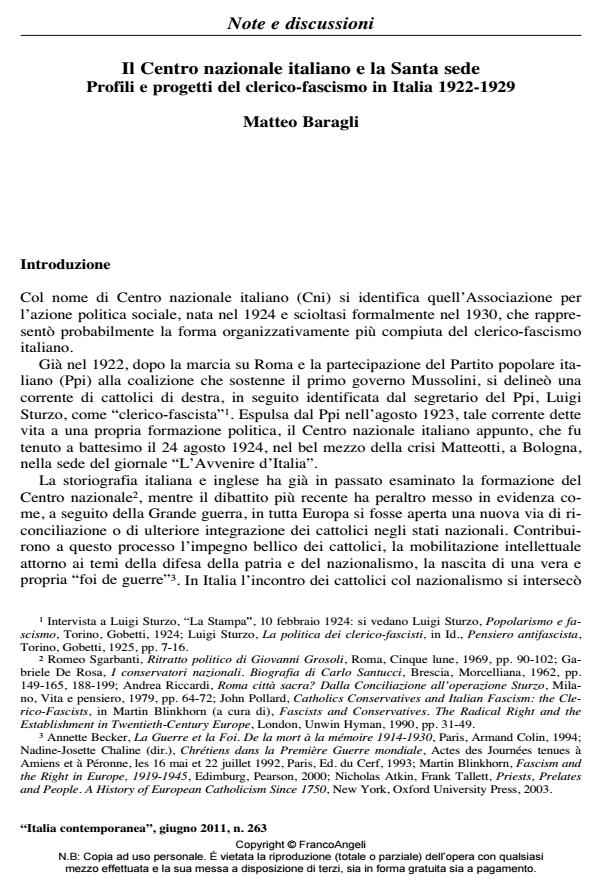The Centro Nazionale Italiano and the Holy See. Features and projects of Italian clerical-Fascism (1922-1929)
Journal title ITALIA CONTEMPORANEA
Author/s Matteo Baragli
Publishing Year 2011 Issue 2011/263
Language Italian Pages 16 P. 239-254 File size 543 KB
DOI 10.3280/IC2011-263004
DOI is like a bar code for intellectual property: to have more infomation
click here
Below, you can see the article first page
If you want to buy this article in PDF format, you can do it, following the instructions to buy download credits

FrancoAngeli is member of Publishers International Linking Association, Inc (PILA), a not-for-profit association which run the CrossRef service enabling links to and from online scholarly content.
This essay examines the life and ideology of the most representative organization of the Italian clerical-fascists, the Centro Nazionale Italiano (CNI), founded in 1924 by a group of conservative and pro-fascist Catholics who had been expelled from the Partito Popolare Italiano. The Cni ensured complete political and parliamentary support to Fascism, firmly convinced of the indissoluble and God-given ties between Catholicism and the Italian nation. Such ties appeared to be confirmed by the pro-catholic policy of Fascism, that was going to restore the public dominance the Catholics had lost with the advent of Liberalism. At first the Vatican appreciated the activity of the Cni, but further on began to entertain growing doubts about their exaggerated pro-fascist bias and manifest independence from the Holy See. This mistrust increased following frictions with the Italian Azione Cattolica and the condemnation of the Action Française. In 1928 Pope Pius XI harshly condemned the Cni, causing the end of this clerical-fascist project, while the compromise between the fascist regime and the Catholic Church was to result in the Lateran Pacts of 1929.
Keywords: Centro Nazionale Italiano (CNI), clerical-Fascism, Vatican, Catholicism, Fascism, Partito Popolare Italiano (PPI)
- What is Christian Democracy? pp.53 (ISBN:9781108368162)
- What is Christian Democracy? pp.80 (ISBN:9781108368162)
- What is Christian Democracy? pp.381 (ISBN:9781108368162)
- What is Christian Democracy? pp.317 (ISBN:9781108368162)
- Race and faith: the Catholic Church, clerical Fascism, and the shaping of Italian anti-semitism and racism Nina Valbousquet, in Modern Italy /2018 pp.355
DOI: 10.1017/mit.2018.34 - What is Christian Democracy? pp.355 (ISBN:9781108368162)
- What is Christian Democracy? pp.248 (ISBN:9781108368162)
- What is Christian Democracy? pp.280 (ISBN:9781108368162)
- What is Christian Democracy? Carlo Invernizzi Accetti, (ISBN:9781108368162)
- What is Christian Democracy? pp.111 (ISBN:9781108368162)
- What is Christian Democracy? pp.1 (ISBN:9781108368162)
- What is Christian Democracy? pp.29 (ISBN:9781108368162)
- What is Christian Democracy? pp.193 (ISBN:9781108368162)
- What is Christian Democracy? pp.169 (ISBN:9781108368162)
- What is Christian Democracy? pp.345 (ISBN:9781108368162)
- The educational project by Pier Paolo Pasolini for democratic citizenship: a critical analysis Irene Gianeselli, Andrea Bosco, in International Journal of Lifelong Education /2025 pp.1
DOI: 10.1080/02601370.2025.2534075 - What is Christian Democracy? pp.139 (ISBN:9781108368162)
Matteo Baragli, Il Centro nazionale italiano e la Santa sede Profili e progetti del clerico-fascismo in Italia 1922-1929 in "ITALIA CONTEMPORANEA" 263/2011, pp 239-254, DOI: 10.3280/IC2011-263004